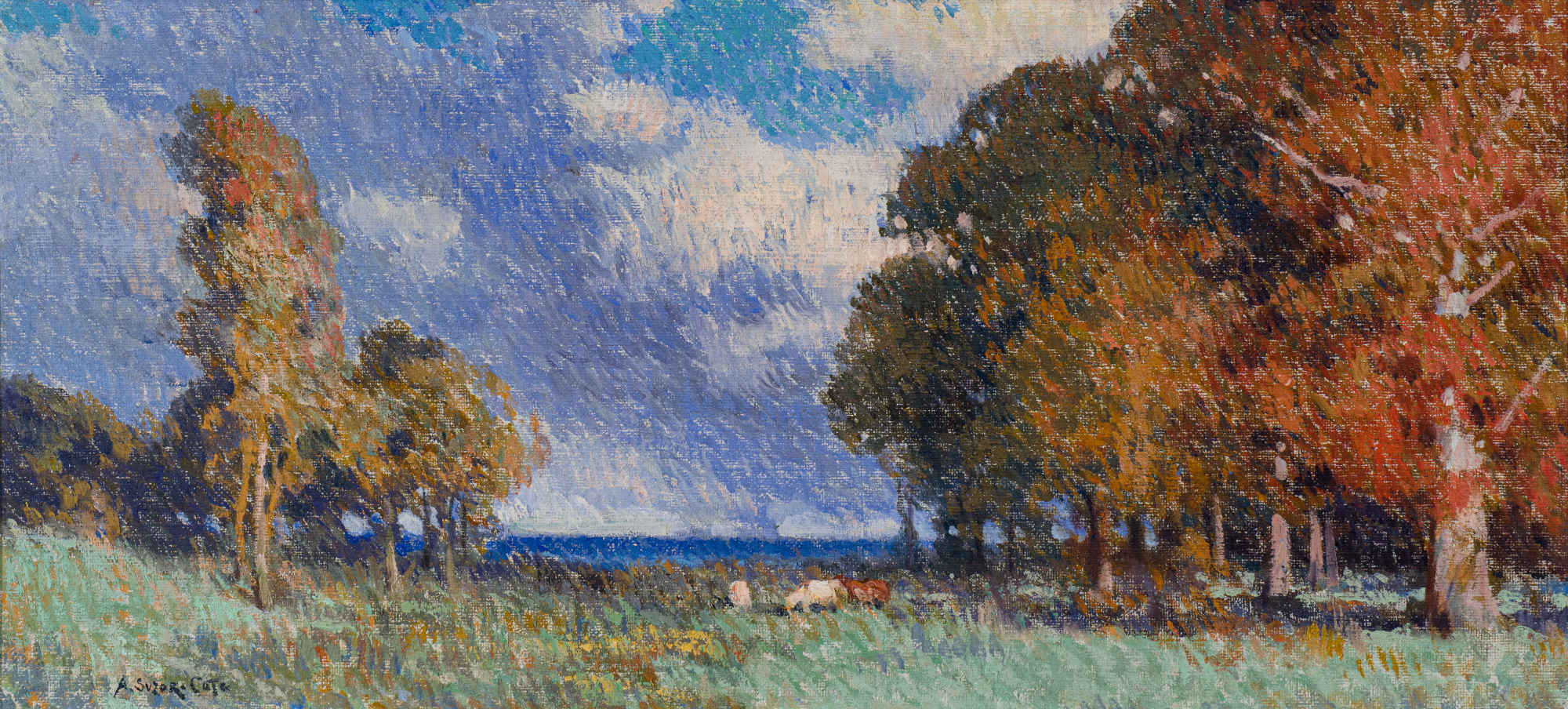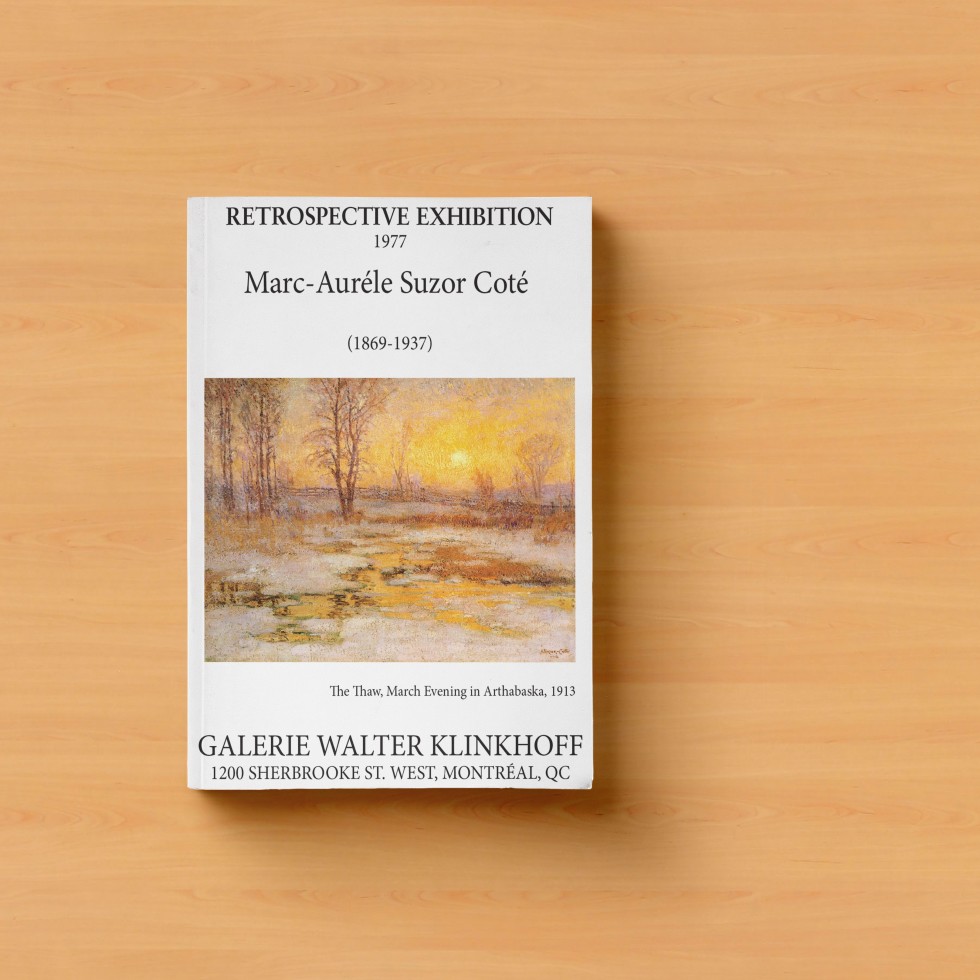Paysage d’automne à Arthabaska, 1909
42.5 x 91.4 cm
Inscriptions
signed, ‘A. Suzor-Cote’ (lower left)Provenance
Watson Art Galleries, Montreal
Acquired from the above by a "Stuart" family
By descent, Stuart family, Kamloops
Galerie Walter Klinkhoff Inc., Montreal
Acquired from the above by a Distinguished Montreal Collector, 1995
Literature
Power Financial Corporation, Annual Report 2002 (Montreal: Power Financial Corporation, 2003), 22 [reproduced].Laurier Lacroix, Suzor-Coté: Lumière et matière (Montréal: Éditions de L’Homme, 2002), 187 [reproduced].
1909 was a turning point in Suzor-Coté’s career. In March, the painter returned from a six-month stay in Virginia, where he had been invited to decorate the breakfast room of Thomas Fortune Ryan’s Oak Ridge villa estate in the Blue Ridge Mountains. Ryan, a billionaire and avid collector, may have met Suzor-Coté through the Fathers of the Blessed Sacrament, who staffed St. Jean-Baptiste Roman Catholic Church in New York, which Ryan financed. The breakfast room commission was an opportunity for the painter to push his pictorial experiment further, adopting a split brushstroke technique that he used for the lunette-shaped paintings that he created. The four landscapes are nestled in the upper part of the room, in a semicircular shape that requires the scene to be adjusted to suit the rounded format. Although Suzor-Coté had already experimented with the Pointillism technique of juxtaposing brushstrokes of different colours (e.g., La Vallée de Senlisse, 1906, MNBAQ), he had never used it in such a systematic, controlled way until the Oak Ridge work, which demanded a particular understanding of the painting’s spatial organization in relation to its shape.
Enriched by this experience with colour, the artist began a series of horizontal landscapes in the summer of 1909, inspired by the natural surroundings of Arthabaska. [1] Twice as long as they are wide, these paintings offer a panoramic view of the landscape—predating Jean-Paul Lemieux’s massive works, which convey the immensity of the Canadian landscape and the solitude of his figures. Far from being a melancholic painter, however, Suzor-Coté celebrated the midday sun in this series, depicting a sense of warmth and well-being.
The reddish hue of the trees on the right suggests that they are oaks, and a poplar stands out against the sky on the left. Other trees are also visible in the distance, and a few cows are grazing in the centre of the composition. The entire surface is animated by strong strokes that move diagonally, which suggests the direction of a light wind that vibrates and sweeps over the entire surface of the painting.
The overall composition follows a broad, low horizon line that draws the viewer into the scene. The painter turned away from the hills of Arthabaska to focus on the plains and the infinite space they exude. Animating this uncluttered landscape was a challenge, but the art of painting, the use of colour and the rhythm infused into the composition, provided the solution. The arrangement of the trees, individually or in irregular groves, emphasizes the depth of the space and its vastness. The viewer’s eyes and mind can absorb this immensity, and Suzor-Coté brings the colours of late summer to life.
Laurier Lacroix
Laurier Lacroix C.M. is professor emeritus at Université du Québec à Montréal, where he taught art history and museology. Among his achievements are exhibitions devoted to Ozias Leduc and Suzor-Coté, as well as Painting in Montreal, 1915–1930, Les arts en Nouvelle-France, Le fonds de tableaux Desjardins, L’atelier comme création. Histoires des ateliers d’artistes au Québec and Becoming Montreal, The 1800s Painted by Duncan. He is also interested in contemporary art and has curated works by Irene F. Whittome, Marc Garneau, Pierre Dorion, Guy Pellerin, Robert Wolfe, Micheline Beauchemin and Lisette Lemieux, among others. Lacroix was the recipient of the Career Award of the Société des musées québécois and the Prix Gérard-Morisset. He is a member of the Société des Dix and the Académie des lettres du Québec
_________________________________
Footnote:
[1] Four other paintings of this series are reproduced in L. Lacroix, Suzor-Coté, lumière et matière, Montreal, Quebec, Ottawa, Les Éditions de l’Homme, Musée du Québec, National Gallery of Canada, 2002, p. 188-191.



















